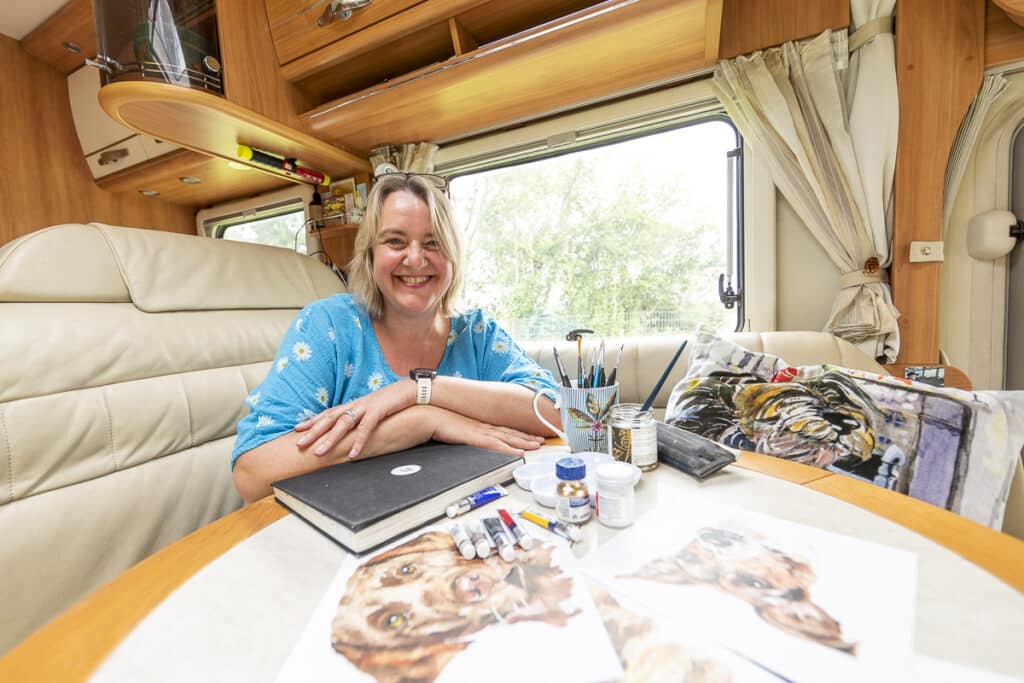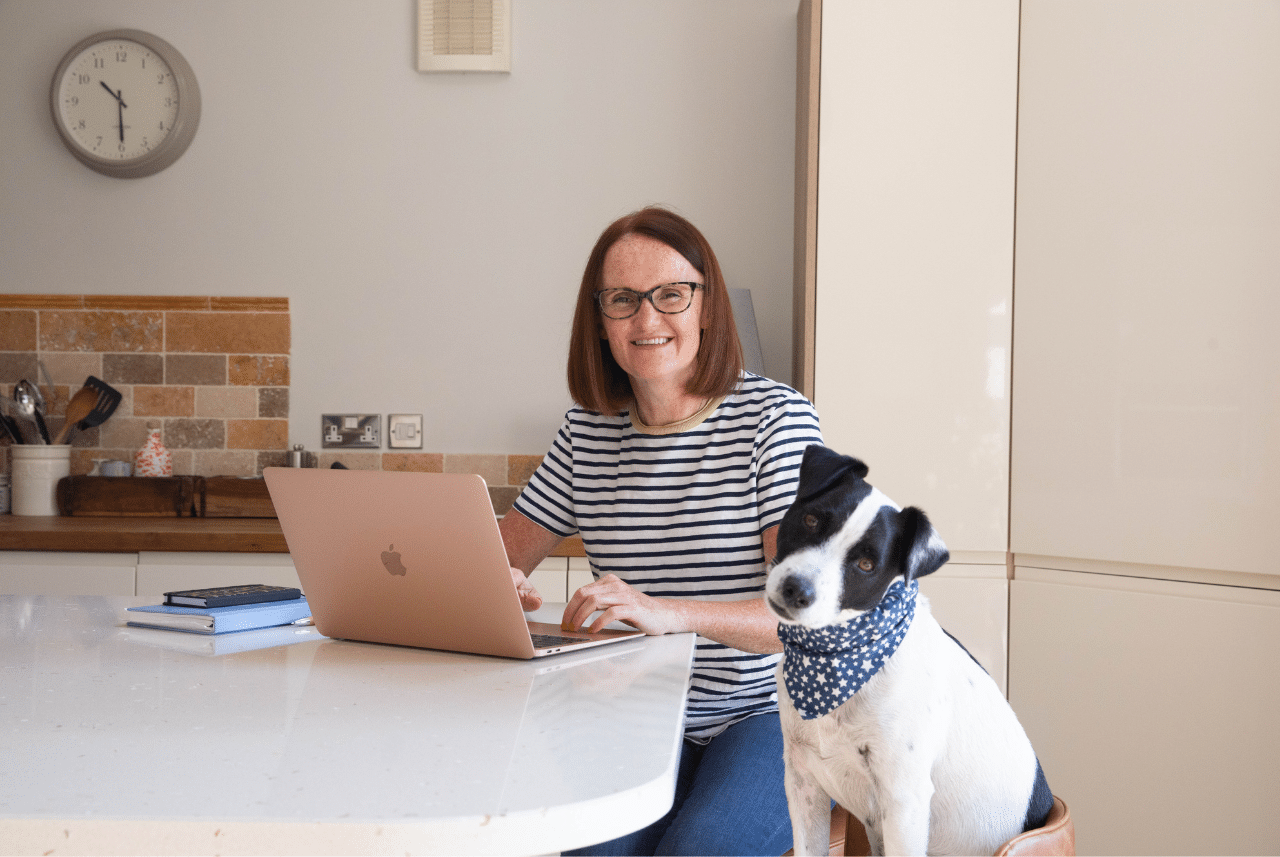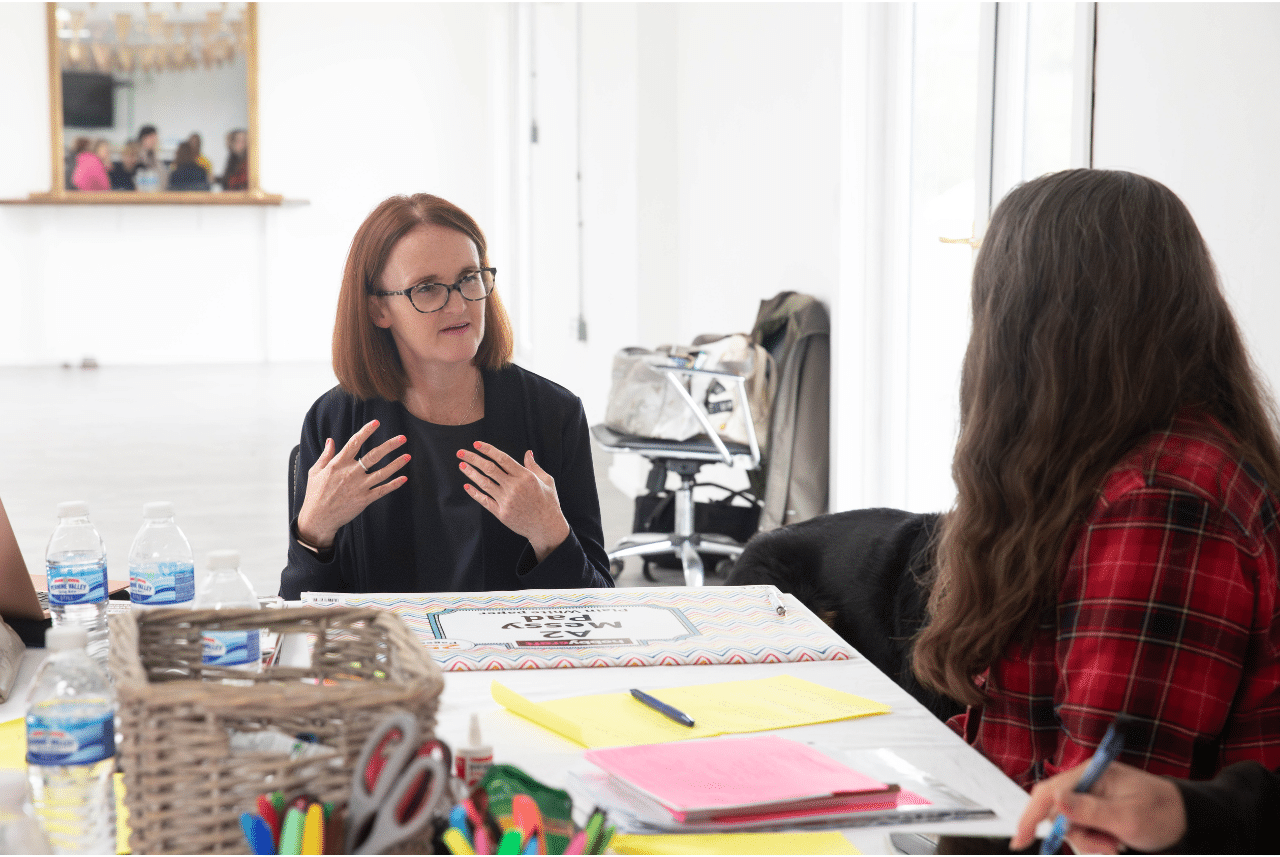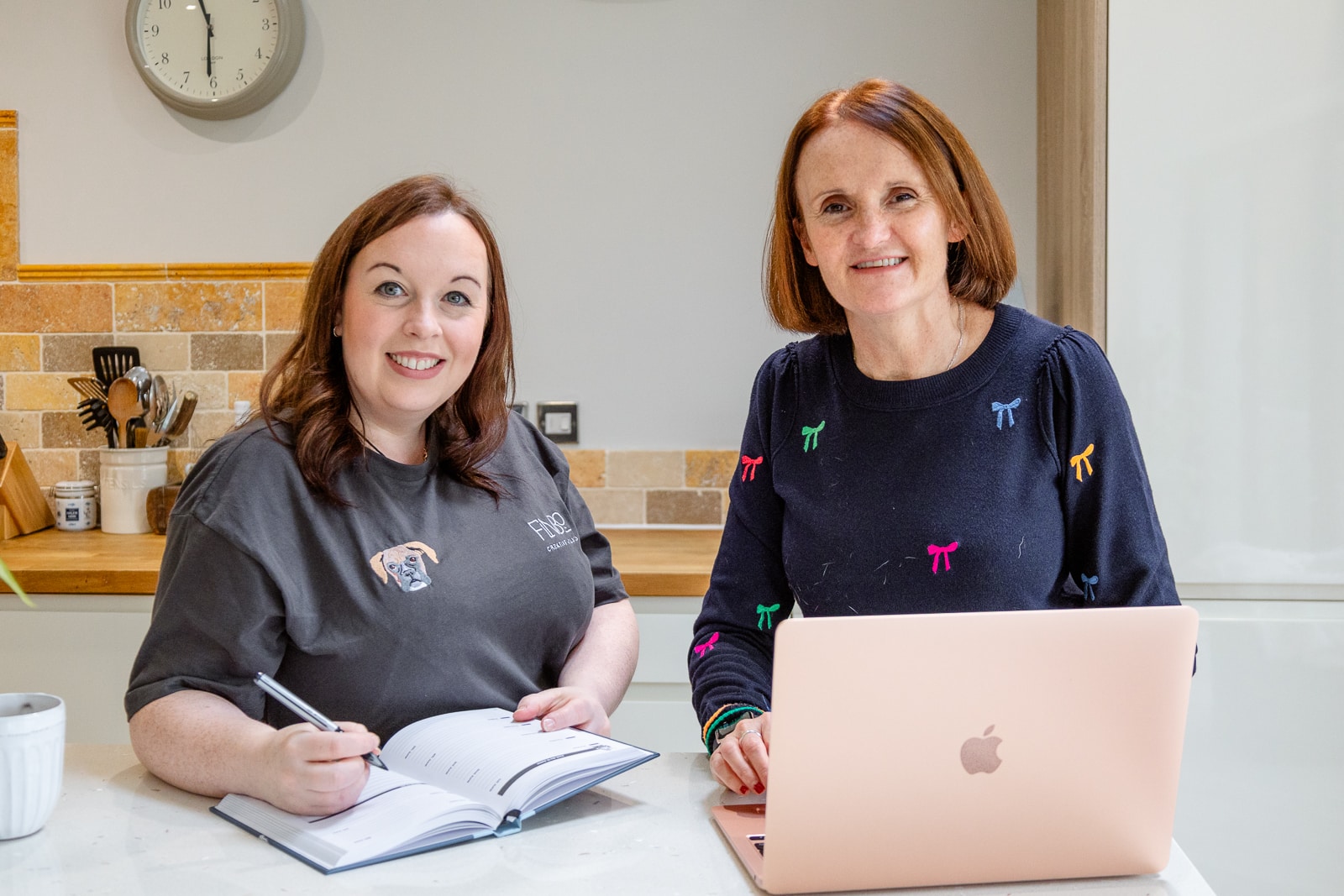Jo Scott is a dog artist, illustrator, Substacker and creative business owner whose work now reaches people all over the world.
Yet just over a decade ago, Jo was working in corporate and dreaming of creating her own greetings cards, something that had been at the back of her mind since Uni.
Her business, Jo Scott Art, began with a single portrait, drawn as a birthday gift for her mother-in-law where just wanted to see if she could capture the likeness of a dog she loved.
That one drawing led to another… and eventually to a full career change in her 40s with Jo following the first career path she’d ever considered.
Jo talks about moving on from a high-pressure job to building a creative business she loves and where she can work from anywhere, including while she’s off on adventures in her motorhome.
She shares how she found her people through Substack and email, how she shows up online in a way that feels right to her, and van life with husband Dean and dog Tomasina.
We talk about how she loves creating work for people who love their dogs as much as she does, creative burnout, comparison, and why it’s OK not to chase massive income numbers or shiny objects.
Jo’s cards are on sale on prestigious sites like Thortful and Moonpig, meaning she gets portrait orders from all over the world, and she works with small retailers, sells from her own website and at events.
If you’ve ever had a niggling idea that won’t go away – or wondered if it’s too late to do something completely different and follow your dreams, you’ll love Jo’s story.
Click the player link below to listen or head to the bottom of the post for a transcript and summary.
Quotes from this episode
“I drew my mother-in-law’s dog for her birthday – just to see if I could – and that one drawing changed everything.”
“I didn’t need a business that made me feel stressed or boxed in. I wanted one that gave me space to breathe.”
“With Substack, I’ve found a way to communicate that I love. I started writing emails and people were replying saying, ‘This feels like you’re inside my head.’”
“Being in the motorhome showed me I could live slower, work differently – and not miss the old version of success.”
“You get to be the kind of artist – or business owner – you want to be. It doesn’t have to look like anyone else’s.”
“It’s never too late to do something different. You can absolutely start again, and do it your way.”
Key takeaways
Jo’s first dog portrait was drawn for her mother-in-law’s birthday – and sparked a total career change.
She built her pet-themed art business slowly, alongside other work, without pressure to scale quickly.
She connects with her audience and builds relationships through email and Substack, not social media trends and values working with other artists.
Choosing to live and work from a motorhome gave her clarity on how she wanted her life to feel like and what ‘enough’ is for her.
Jo’s story is proof that it’s never too late to do something you love, and you don’t need to be everywhere and running yourself ragged to make an impact.
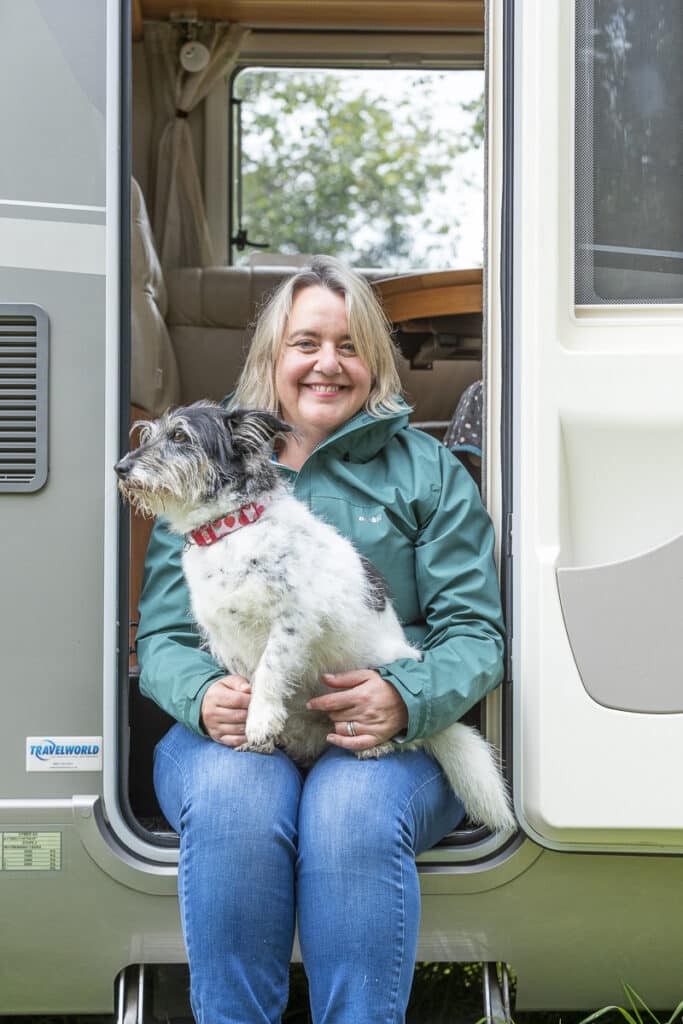
Topics and timings in this episode
1.30 – Jo’s first dog portrait and how it all began
4.10 – Why art was always her thing (and what took her away from it)
7.30 – Moving from a creative agency career to working for herself
10.15 – Starting over in her 40s and building a pet-themed business
14.20 – Creating her first greeting cards and finding her niche
17.40 – Building confidence and showing up online in her own voice
21.00 – Finding her people through email and Substack
26.10 – What helped her stop comparing herself to other creatives
30.00 – Choosing slow growth and redefining success
35.15 – Jo’s motorhome life and how she’s experiencing a different pace of business
41.00 – Creating from joy instead of pressure
45.20 – Selling at events like Crufts and what Jo has learned from in person shows and learning as she went
49.10 – Creative burnout and how she protects her energy
53.30 – What she’s learned about audience building and visibility
58.00 – Jo’s advice for anyone starting (or restarting) something new
1.02.00 – Why your version of success doesn’t need to look like anyone else’s
Resources mentioned in this episode
Jo’s website: https://joscottart.com
Jo on Instagram: https://instagram.com/joscottart
Substack: Jo Scott’s newsletter on art, dogs and creative life https://substack.com/@joscottartist
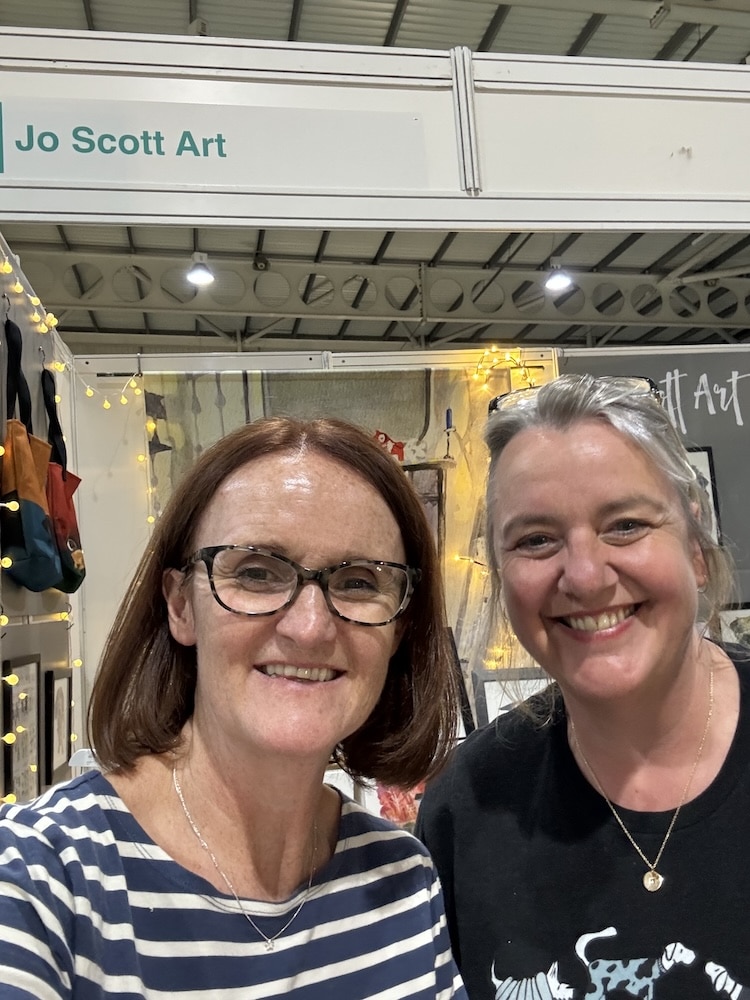
Further listening/reading
How to start a pet business newsletter
Is my Pets Get Visible membership right for you?
Pet business content and social media calendar
In the spotlight with Debbie Humphries from Redhound for Dogs
Clayton Payne – lessons from 30 years in the pet industry
Laura Dixon – how to build a tribe around your pet business
Sandra Emmons – how to include your local community in your dog training business
Episode summary – this has been created using AI
Rachel Spencer:
So, hi Jo, thanks so much for coming on the podcast. It’s great to have you here. Can you tell me a little bit about you and what you do?
Jo Scott:
Well, my absolute pleasure. Thank you for having me. I’m an artist and illustrator, and I’ve been doing that for about 15 years. My specialty is dogs. I paint pet portrait commissions, I do licensing — I’m paid royalties for other businesses to use my work — and I design a range of greeting cards. It’s a bit like a portfolio business with several revenue streams.
For the last five years, I’ve taken the business with me and we’ve been travelling for about three quarters of the year around the UK, Europe, and sometimes a bit further afield in our motorhome.
Rachel Spencer:
My gosh, that’s a proper dream, isn’t it? I love it. So tell me about how you got into doing what you do now. Did you have a career before you became an artist?
Jo Scott:
I did. This is a second career for me. I didn’t start this until I was in my early forties. I went to art college after school — my parents were very supportive, they said, “If you can find a way to earn money from your art, that’s brilliant.”
But my work was always quite commercial and cartoony, which was frowned upon in art college. I didn’t really click. I didn’t fall into one of the main categories for future work and I felt a bit out of place.
I switched and went into office jobs. I was training people on how to use software but still within arts organisations. I worked with Tate Galleries, the Barbican Centre, and the Royal Collection — I was in Buckingham Palace training people on software. That’s another podcast in itself.
But niggling away, I was always the person who did the leaving card in the office. I was always drawing. Then I was working for a startup company — they were a complete bunch of idiots really — and I thought, gosh, if they can do this on their own, why can’t I?
That’s where the idea for starting my own business came from. Working in offices really helped in terms of knowing what I needed to know business-wise — accounting, bookkeeping — and that was quite natural to take across to my own business.
I really fell on greeting cards first. At the same time, I’d done a portrait of my mother-in-law’s dog as a birthday present. We were a bit low on cash one year and it was her big birthday. I thought, let me see if I can paint the dog because she loves her dog.
She loved it. Everybody loved it. And then people started to ask me to paint. Well, everybody got a dog or cat portrait that year. Then friends of friends and family friends started to ask me too. I thought, oh, there’s something in this.
The commissions I got effectively paid to start up the greeting card business. The commissions have always been there and not gone anywhere. That’s how it all started.
Rachel Spencer:
I love this. So it’s all thanks to your mother-in-law then, and you being a bit skint when it was her big birthday.
Jo Scott:
Pretty much, yes. It kicked off something that was a pivotal moment.
Rachel Spencer:
How did you get the confidence to make that leap? Because you’d had this really steady job and then you went to go and do this on your own.
Jo Scott:
It was a mixture of things coming together. One was that I had more time — I was working as a consultant part-time. The other was that people were paying me money. When you put your price up and people still pay, then you realise you can keep going with that.
And then, because I was doing the greeting card research and starting to do trade shows, I thought, right, I’m going to put the two things together.
It was also that I didn’t want to go back into a big company. I thought, actually, I want to make this work. I want to make this something that is my own.
Rachel Spencer:
I love that you said it was kind of a slow build, because I think sometimes we have this idea that people just start a business and all of a sudden they’re successful, but it does take time, doesn’t it?
Jo Scott:
Oh yeah. I think it took me about four years before I had money that I could take out of the business. It was a long slog. I could see the light at the end of the tunnel, but it was going to take a while.
We did make sacrifices along the way, but we were okay. We weren’t on the breadline. It was just a slow burn.
Rachel Spencer:
And during that time, what were the things that you were doing?
Jo Scott:
I did trade shows, consumer shows, quite a lot of country fairs. The first couple of years I didn’t make any money from them, but I learnt so much — how to talk to people, what people wanted, what they didn’t want.
It was good for getting feedback and testing ideas.
Rachel Spencer:
And did you find it was the greeting cards that people were picking up, or was it the commissions that people were coming to you for?
Jo Scott:
It was both. People love to buy something they can take away with them. But the greeting cards were also a fantastic marketing tool because I always had my details on the back.
The amount of commissions I have got through people saying, “We received one of your cards,” has been incredible. That became a fantastic marketing tool, completely by accident.
Rachel Spencer:
Did you find that the designs you really loved were the ones that did best, or was it the things you thought people would want?
Jo Scott:
My most successful designs are the ones that are really personal to me, the ones I get excited about. If I’m really into it, generally it does really well.
Rachel Spencer:
At one point you thought you wanted to make greeting cards your whole business. What changed?
Jo Scott:
I did think I wanted to scale greeting cards. But I went to a talk and heard other card publishers talking about warehouses, HR, managing staff, all of that. The blood drained from my face. I thought, I don’t want that. I just want to be free.
That’s when I realised I didn’t want to build that kind of business. I wanted to work differently.
Rachel Spencer:
And that’s when licensing and royalties came in?
Jo Scott:
Yes. Licensing gave me freedom. People pay to use my artwork on products, and I earn royalties. It means I don’t need warehouses or staff, but my work can still be out in the world.
Rachel Spencer:
You’ve also started using Substack. How has that been for you?
Jo Scott:
I started writing about our travels and my sketchbook, but then I began sharing the mistakes I’d made when I first started out in greeting cards. I enjoy writing, it’s conversational, down to earth.
Substack has been brilliant for visibility. One of my paintings was featured on Substack itself, and from that I got 15 commissions and 250 new subscribers.
I can see a direct correlation between Substack and website visits. It’s been brilliant.
Rachel Spencer:
Tell me about life on the road. What’s it like running your business while travelling?
Jo Scott:
It does sound ideal, and it is, but there’s guilt sometimes. You’re in a beautiful location and you’re sat inside working. It’s about arranging your time so you can enjoy both.
Rachel Spencer:
And financially, has it been what you expected?
Jo Scott:
I’ve matched my old salary once in the last 15 years. But it doesn’t matter. I’m earning enough, plenty to see us through. For me, it’s not about chasing more and more. It’s about enough.
Rachel Spencer:
What advice would you give to someone sitting on an idea or a passion project?
Jo Scott:
You really do know what is best for you. Follow your gut. Be open to change, don’t have a fixed mindset about how something is going to look. And you may as well do it sooner than later.

